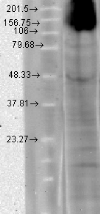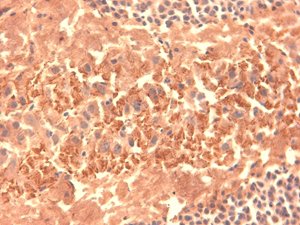抗HCN4モノクローナル抗体(Anti-HCN4) HCN4 antibody (S114-10:クローン名) | StressMarq Biosciences
掲載日情報:2017/10/30 現在Webページ番号:26626
HCN4に対するモノクローナル抗体 (Anti-HCN4) HCN4 antibody (S114-10:クローン名) です。
※本製品は研究用です。研究用以外には使用できません。
[在庫・価格 :2025年12月13日 15時55分現在]
※ 表示されている納期は弊社に在庫が無く、取り寄せた場合の納期目安となります。
| 詳細 | 商品名 |
|
文献数 | ||||||||||||||||||||||||||||||||||||||||||||||||||||||||||||||||||||||||||
|---|---|---|---|---|---|---|---|---|---|---|---|---|---|---|---|---|---|---|---|---|---|---|---|---|---|---|---|---|---|---|---|---|---|---|---|---|---|---|---|---|---|---|---|---|---|---|---|---|---|---|---|---|---|---|---|---|---|---|---|---|---|---|---|---|---|---|---|---|---|---|---|---|---|---|---|---|---|
|
Anti-HCN4, Mouse-Mono(N114/1) |
|
3 | |||||||||||||||||||||||||||||||||||||||||||||||||||||||||||||||||||||||||||
|
|||||||||||||||||||||||||||||||||||||||||||||||||||||||||||||||||||||||||||||
[在庫・価格 :2025年12月13日 15時55分現在]
※ 表示されている納期は弊社に在庫が無く、取り寄せた場合の納期目安となります。
Anti-HCN4, Mouse-Mono(N114/1)
文献数: 3
- 商品コード:SMC-320D
- メーカー:STQ
- 包装:100μg
- 価格:¥72,000
- 在庫:無(未発注)
- 納期:2~3週間 ※※ 表示されている納期は弊社に在庫がなく、取り寄せた場合の目安納期となります。
- 法規制等:
| 説明文 | 別名:Hyperpolarization activated cyclic nucleotide gated potassium channel 4,HCN 4,Potassium/sodium hyperpolarization activated cyclic nucleotide gated channel 4 クローン:N114/10 (Formerly sold as S114-10) Genbank No: 59266 Gene Accession No: NP_067690.1 Protein Accession No: Q9JKA7 |
||
|---|---|---|---|
| 法規制等 | |||
| 保存条件 | -20℃ | 法規備考 | |
| 抗原種 | Rat | 免疫動物 | Mouse |
| 交差性 | Human/Mouse/Rabbit/Rat | 適用 | Antibody Microarray,FCM,IC,IF,IHC,Western Blot |
| 標識 | Unlabeled | 性状 | Protein A/G Affinity Purified |
| 吸収処理 | クラス | IgG | |
| クロナリティ | Monoclonal | フォーマット | |
| 掲載カタログ |
ニュース2022年6月15日号 p.34
|
||
| 製品記事 | 抗HCN4抗体 | Anti-HCN4 antibody 抗イオンチャネル(Ion Channel)抗体 神経科学(Neuroscience)研究用 抗体/タンパク質 (StressMarq Biosciences社) |
||
| 関連記事 | |||
カートに商品を
追加しました。
追加しました。
製品情報
Product Name
HCN4 Antibody
Type
Monoclonal
Datasheet
Description
Anti-HCN4
Research Area
Ion Channels, Neuroscience
Alternative Names
Hyperpolarization activated cyclic nucleotide gated potassium channel 4, HCN 4, Potassium/sodium hyperpolarization activated cyclic nucleotide gated channel 4
Clone Number
S114-10
Host Species
Mouse
Isotype
IgG1
Immunogen
Fusion protein amino acids 1019-1198 (c-terminus) of rat HCN4, accession number Q9JKA7
Applications
WB, ICC, IHC, IF
Species Reactivity
Human, Mouse, Rat
Accession Number
NP_067690.1
Gene ID
59266
SwissProt
Q9JKA7
Background Info
Detects ~130kDa. No cross-reactivity against other HCNs
Recommended Dilutions
1-10ug/mL (WB), 0.1-1.0ug/mL (Perox) (IHC/ICC)
Form
Protein G Purified
Storage Buffer
PBS pH7.4, 50% glycerol, 0.09% sodium azide
Certificate of Analysis
1 µg/mL of SMC-320 was sufficient for detection of HCN4 in 10µg of COS cell lysate transiently transfected with HCN4 by colorimetric immunoblot analysis using Goat anti-mouse IgG:HRP as the secondary antibody.
References
Research Background
Ion channels are integral membrane proteins that help establish and control the small voltage gradient across the plasma membrane of living cells by allowing the flow of ions down their electrochemical gradient (1). They are present in the membranes that surround all biological cells because their main function is to regulate the flow of ions across this membrane. Whereas some ion channels permit the passage of ions based on charge, others conduct based on a ionic species, such as sodium or potassium. Furthermore, in some ion channels, the passage is governed by a gate which is controlled by chemical or electrical signals, temperature, or mechanical forces. There are a few main classifications of gated ion channels. There are voltage- gated ion channels, ligand- gated, other gating systems and finally those that are classified differently, having more exotic characteristics. The first are voltage- gated ion channels which open and close in response to membrane potential. These are then separated into sodium, calcium, potassium, proton, transient receptor, and cyclic nucleotide-gated channels; each of which is responsible for a unique role. Ligand-gated ion channels are also known as ionotropic receptors, and they open in response to specific ligand molecules binding to the extracellular domain of the receptor protein. The other gated classifications include activation and inactivation by second messengers, inward-rectifier potassium channels, calcium-activated potassium channels, two-pore-domain potassium channels, light-gated channels, mechano-sensitive ion channels and cyclic nucleotide-gated channels. Finally, the other classifications are based on less normal characteristics such as two-pore channels, and transient receptor potential channels (2). Specifically, hyperpolarization-activated cation channels of the HCN gene family contribute to spontaneous rhythmic activity in both the heart and brain (3).
References
1. Hille B. (2001) Ion Channels of Excitable Membranes, 3rd Ed., Sinauer Associated Inc.:Sunderland, MA USA.
2. www.iochannels.org
3. Zong X., et al. (2005) J Biol Chem. 280(40): 34224-34232
Ion channels are integral membrane proteins that help establish and control the small voltage gradient across the plasma membrane of living cells by allowing the flow of ions down their electrochemical gradient (1). They are present in the membranes that surround all biological cells because their main function is to regulate the flow of ions across this membrane. Whereas some ion channels permit the passage of ions based on charge, others conduct based on a ionic species, such as sodium or potassium. Furthermore, in some ion channels, the passage is governed by a gate which is controlled by chemical or electrical signals, temperature, or mechanical forces. There are a few main classifications of gated ion channels. There are voltage- gated ion channels, ligand- gated, other gating systems and finally those that are classified differently, having more exotic characteristics. The first are voltage- gated ion channels which open and close in response to membrane potential. These are then separated into sodium, calcium, potassium, proton, transient receptor, and cyclic nucleotide-gated channels; each of which is responsible for a unique role. Ligand-gated ion channels are also known as ionotropic receptors, and they open in response to specific ligand molecules binding to the extracellular domain of the receptor protein. The other gated classifications include activation and inactivation by second messengers, inward-rectifier potassium channels, calcium-activated potassium channels, two-pore-domain potassium channels, light-gated channels, mechano-sensitive ion channels and cyclic nucleotide-gated channels. Finally, the other classifications are based on less normal characteristics such as two-pore channels, and transient receptor potential channels (2). Specifically, hyperpolarization-activated cation channels of the HCN gene family contribute to spontaneous rhythmic activity in both the heart and brain (3).
References
1. Hille B. (2001) Ion Channels of Excitable Membranes, 3rd Ed., Sinauer Associated Inc.:Sunderland, MA USA.
2. www.iochannels.org
3. Zong X., et al. (2005) J Biol Chem. 280(40): 34224-34232
カートに商品を
追加しました。
追加しました。
製品情報は掲載時点のものですが、価格表内の価格については随時最新のものに更新されます。お問い合わせいただくタイミングにより製品情報・価格などは変更されている場合があります。
表示価格に、消費税等は含まれていません。一部価格が予告なく変更される場合がありますので、あらかじめご了承下さい。








